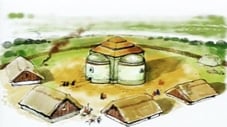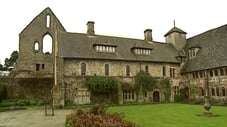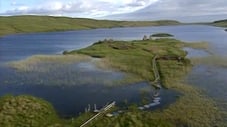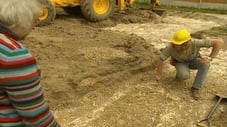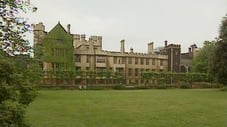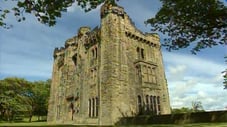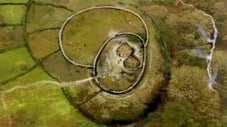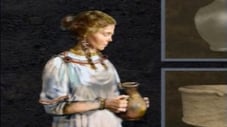
Time Team (1994)
← Back to main
Robin Bush as Self - Archivist
Episodes 15
The Guerrilla Base of the King - Athelney, Somerset
In this first ever episode of Time Team, Tony and the team travel to Athelney in Somerset to investigate a series of hills (once islands in a bog) that became Alfred The Great last defensive positions after a series of losses to invading Viking forces. It is also the place Alfred began the great rally that saw him re-conquer most Wessex and laid the foundations of the nation that was to become England.
Read MoreOn the Edge of an Empire - Ribchester, Lancashire
Ribchester in Lancashire has been known for some time as a site of a Roman fort. The Time Team arrive in the town to answer two questions, one is to consolidate all the previous excavations on the site, and the second to define the outline of a possible older wooden fort that is thought to have been in the area.
Read MoreThe New Town of a Norman Prince - Much Wenlock, Shropshire
The Time Team go to the small town of Much Wenlock, after they receive a letter from a resident explains a recent excavation uncovered possibly the oldest house in the town. What they discover is the remains of an old Saxon village transitioning into a larger newer Norman settlement.
Read MoreThe Fortress in the Lake - Llangorse Lake, Powys
The Time Team travel to Brecon Beacons in Wales, they have come to investigate a small man-made island in Llangorse Lake. Locals tell many strange legends including hearing the sounds of Church bells echoing across the body of water at night. The Team want to know who built the island and try to find evidence to support the stories of it eventual fall into disuse.
Read MoreLord of the Isles - Finlaggan, Islay
The Time Team travel to a group of islands on the western side of Scotland to investigate a culture known as the "Lords of the Isls" - who ruled the islands 1000 years ago. The team joins a group from the Scottish National University who've been working in the area for some five years uncovering the history of these people. What the Time Team discovers throws the whole excavation into a new light and suggests people may have lived in the area thousands of years prior.
Read MoreThe Saxon Graves - Winterbourne Gunner, Wiltshire
The Time Team visit Hylton Castle near Sunderland. A local group want to redevelop the local area as a tourist attraction but don't want to disturb any hidden structures.
Read MoreThe Lost Villa - Tockenham, Wiltshire
Tockenham village, in the Wiltshire countryside. Despite the fact that there are no Roman remains in Tockenham, the village's 15th century church, St Giles, has a small pagan Roman statue embedded in one of its outer walls.
Read MoreThe Archbishop's Back Garden - Lambeth Palace, London
The Time Team traveled to Lambet Palace in the heart of London. They are trying to unravel the enigma of why the Romans crossed the Thames in a different area to where they developed the city. The team needs to employ some extreme archeology to try an understand what the Romans where thinking.
Read MoreMedieval Dining Hall - Hylton Castle, Sunderland
The Time Team travel to Winterbourne Gunner in Wiltshire to investigate a housing development that has come to a halt because of an alarming number of Saxon graves found in the area They successfully work their way through the maze of finds but in doing so discover what seems to be a whole new layer of history in the town.
Read MorePrehistoric Fogou - Boleigh and Treveneague, Cornwall
Recorded between 17 and 19 March 1995, the team try to discover what a 2000-year-old underground chamber (fogou) beneath Jo May's garden was used for. Dowser Hamish Miller shows the extent of the fogou beneath the lawn, and Tony tries his hand at dowsing. But Mick is skeptical, preferring to rely on the geophysical survey. They are also trying to find the Iron Age settlement that would have adjoined the fogou. Joining the team are archaeological geophysicist Susan Ovenden, and county archaeologist Nick Johnson. The programme includes an experiment in extracting pure tin from the local stream.
Read MoreHunting for Mammoth - Stanton Harcourt, Oxfordshire
Recorded between 21 and 23 April 1995, in this episode the team go to a gravel pit that is soon to become landfill, where they attempt to unearth 200,000-year-old remains of mammoths and other prehistoric animals. Gravel pits are typical sites for paleolithic remains. But the chances of finding evidence of any prehistoric peoples are remote. Joining the team are Christine Buckingham, Kate Scott, and palaeontologist Russell Coope. Wood anatomist Rowena Gale tries to match ancient and modern wood samples For this episode the team are joined by archaeologist Kate Scott and geologist Christine Buckingham.
Read MoreVillage of the Templars - Templecombe, Somerset
Recorded between 26 and 28 May 1995. A 13th century picture of Christ, strikingly similar to that on the Turin Shroud, has turned up. It's believed to belong to the Knights Templar, a medieval order of monks who gave their name to the village of Templecombe. The team investigate a manor house thought to be on the site of a monastery. What's left of the monastery, and who were the Templars anyway? So far all the evidence seems to be outside the house, where Phil and the team have already dug up pieces of encaustic tile. Carenza and Robin are doing some research among the documents.
Read MoreA Wreck of the Spanish Armada - Teignmouth, Devon
Recorded between 30 June and 2 July 1995. 20 years ago a teenage boy discovered a 400-year-old bronze cannon in water close to the south Devon coast. Nobody has yet identified the ship it belonged to. Will there be enough left of the wreck to identify it? As usual, Time Team have only three days to find out. Tony is looking forward to getting into his diving suit. But the team cannot dive until the wreck's archaeological supervisor, Chris Preece, arrives. Meanwhile the wreck's finder, Simon Burton, tells his story. Undeterred by disappointing geophysics results, the divers go ahead with their search in murky water. On land, armoury expert Nicholas Hall demonstrates the cannon. Ultimately Robin comes up with a theory about the ship's origin and purpose.
Read MorePalace of the Irish Kings - Emain Macha (aka Navan Fort), County Armagh
Recorded between 7 and 9 April 1995, the team are at Emain Macha (aka Navan Fort), County Armagh, where according to Celtic legends three palaces were built. The evidence of two have been found and the team try to find evidence of the third.
Read MoreTreasures of the Roman Field - Lavenham, Suffolk
Recorded between 28 and 30 August 1995. The team arrive in a large square field about 20 miles from Colchester. This is an area typically rich in Roman activity. Several remains have previously been dug up, including coins, an elaborate key, and Samian ware. Adrian Thorpe, the farmer, wants to know more. The indications are of a settlement with high status buildings, maybe timber-framed. With recycled fragments of genuine Roman glass, fired up in a homemade furnace, glassblower Ed Iglehart creates an authentic conical beaker. Among hundreds of finds is a metal owl brooch. They are joined by Jude Plouviez from Suffolk County Council, Roman specialist Lindsay Allason-Jones, environmental archaeologist Peter Murphy, and coin specialist Daphne Briggs.
Read More